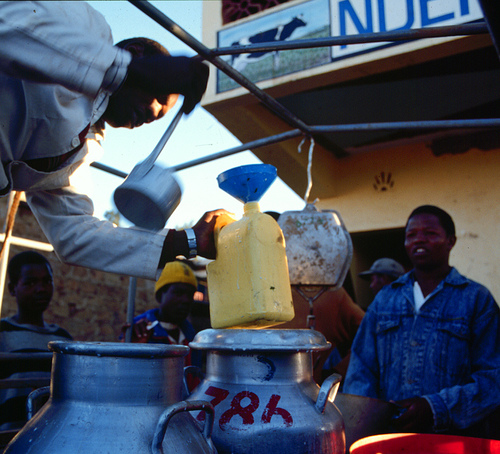 Weigh of milk at a collection centre. Milk production and supply by farmers to milk factories has increased due to ongoing rains across the country that has resulted to more pasture grass for livestock. Photo: ILRI/Dave Elsworth.
Weigh of milk at a collection centre. Milk production and supply by farmers to milk factories has increased due to ongoing rains across the country that has resulted to more pasture grass for livestock. Photo: ILRI/Dave Elsworth.
Brookside Dairy has for the past one week recorded an increase of 30 per cent in milk supply to the processor by its 160,000 contracted farmers across the country. This is against Kenya Dairy Board (KBD) Milk Production and Marketing in Kenya 2013 report which listed low raw milk delivery at factory gates as one of the challenges facing dairy sector in Kenya.
The increase has come barely a week after the Ruiru-based company announced an increase of 42 per cent in farm-gate prices of milk bought from its collective centres in key production regions across the country.
“Our price increase from Sh26 per kilo of raw milk to Sh37 has spurred the production and delivery of the produce by our farmers,” said John Gethi, the firm’s milk procurement director.
“We would like our farmers to adopt climate-smart practices such as establishment of fodder plots on their farms with the current rains, that I why we increased their earnings per kilo of milk they deliver to us as a way of supporting them financially.”
RELATED NEWS: Farmers to earn Sh11 more per litre by selling milk to Brookside
The milk price increase was against the industry trend where during rainy season there could be a drop in raw milk price supplied to milk processors due to increase in pasture grass production translating to more feeds for livestock and more milk production and supply leading to milk glut.
The company is now embanking on fodder trees planting having donated seedlings to it farmers to plant this rainy season increasing fodder production that will ensure enough feeds for their cows for steady milk production and supply even after the rains.
“We are looking forward to a situation where the country will have optimum supplies of milk across all seasons due to abundance of conserved animal feed,” said Gethi.
This is a relief for smallholder dairy farmers who are producing over 90 per cent of the national milk against the less 10 per cent of national milk production by large scale dairy farmers who can afford sustainable fodder production.
RELATED NEWS: Milk preserving technology extends shelf life by 30 days, boosting farmers’ revenue
According to Gethi, fodder trees are easy to grow as they need little land, labour or capital and have numerous by-products and often has a year round supply of animal feed.
The Kenya dairy sector plays a critical role in the livelihood of many Kenyans and contributes 4.5 per cent of total country’s gross domestic product (GDP), making Kenya one of the largest producers of milk in Africa, according to KDB.
A survey conducted by Smallholder Dairy Project (SDP) claims that there are approximately 6.7 million dairy cattle in Kenya while Food and Agricultural Organization (FAO) estimates the population of milking animals to be 5.5 million.
RELATED NEWS: Milk company to buy produce from over 160,000 farmers
















Comments powered by CComment